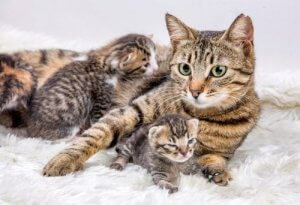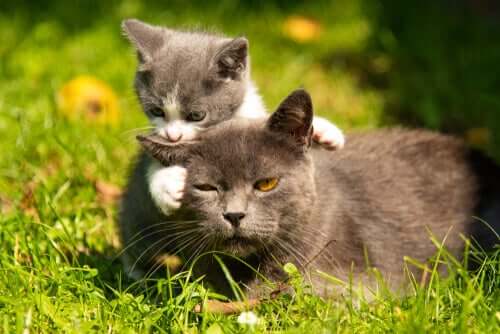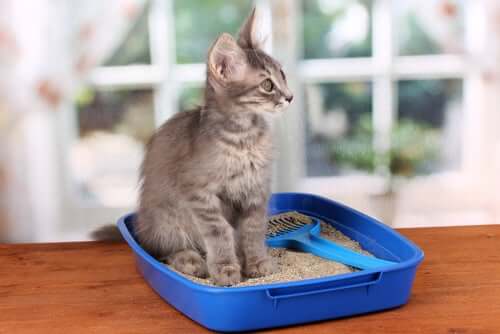How and When to Move Your Litter of Kittens

Generally speaking, a mother will always look for a safe place to raise her litter of kittens. She will usually choose somewhere that is quiet, dark, dry, warm and safe from any predators, male cats or curious humans.
If a mother is calm and healthy after giving birth, then you don’t need to move your litter straight away. When the kittens are two weeks old, you can start to play more of a role in raising them. Sometimes, the mother doesn’t choose the best place to give birth to her litter. This can be because she is inexperienced, because of changes in the environment, or it can just be a poor choice.

In these cases, you might need to decide to move the kittens to a better, more protected place. However, it’s important to bear in mind that, if you move the kittens too early, you can make their mother anxious. In extreme cases, a mother might abandon her litter if it is moved by a human.
This article will provide a few key tips to help you know when to move your cat’s litter.
1. Watch how your cat behaves with her litter
Hopefully, your cat should already be quite comfortable around you and will trust you to care for her. If this is the case, then your cat shouldn’t feel anxious or concerned when you get close to her or her kittens. When you move around her bed, move slowly so that you can watch her reaction before you handle any of her kittens.

2. Choose the right place to move your litter of kittens
There are a couple of questions you can ask yourself to know if you’ve chosen the right place to put your litter of kittens:
- Can you close off the area to prevent the mother from moving her kittens?
- Is the area big enough for a litter box to allow the mother to do what she needs?
- Is there a safe place where you can put water and food bowls, away from the litter box?
The area should also be very quiet. This means that it should be away from any busy areas of the house and any noise from the TV, phone, or radio.
It should also be sheltered from any drafts and kept at a moderate temperature, ideally around 25°C.
One option is to use wardrobes in your guest bedroom or another bedroom that you don’t often use. Other areas that would work well are corners of a laundry room or coatroom, or a basement, as long as it’s dry and warm.
3. Make up a new bed for your litter of kittens
Once you’ve chosen the best spot, you can put together your litter’s bed. A solid cardboard box, the same length and width as your cat, will be an ideal bed.
Washing baskets can also be an excellent bed, as long as any openings are less than an inch wide. If they’re any bigger, the kittens might slide through and risk getting injured or cold.
4. Ensure the bed is comfortable and warm
Cover the bottom of the bed with a thick towel, a blanket, or a piece of old clothing, and then place the bed in your chosen spot. Make sure you also move the cat’s litter tray and any food or water bowls. In the end, what you want to create is a place where the mother will feel comfortable and the kittens will be safe and warm.

5. Move the litter and their mother together
Encourage the mother to move from her current spot by tempting her with a tasty treat. Small pieces of cooked chicken or spoonful of canned tuna should do the trick. The idea is to move her from her bed, but without shooing or scaring her. She has to be able to see what you’re doing, but from a short distance away. Take the kittens from their old bed, but make sure you handle them carefully so that you don’t drop them.
The kittens may call out to their mother to try to attract her attention when you handle them, but don’t let their meows discourage you from moving them to their new safe bed.
6. Place the mother in her new bed
Encourage the mother to follow you to her new bed. Let her watch while you place the bed and the kittens in their new home. It’s important to let the mother follow her kittens to the new bed. Some mothers might think their kittens will be harmed and might act aggressively.
If you think the mother might try to protect her kittens when you move them, it’s a good idea to wear long sleeves and thick gloves for protection.

7. Keep them in their new bed and let them adjust
Once all the kittens and their mother are in the new bed, close the door. Check on them every now and again throughout the day, but try to leave the family to get used to their new home.
Initially, the mother will probably not like her new bed and will want to move and hide her kittens again. With this in mind, try to find somewhere where the mother can’t get out easily.
Give the mother a treat once or twice a day for a couple of days to encourage her to accept her new home.
She might be irritated to begin with, but little by little she should become calmer. Make sure she and the kittens have everything they need and that the mother is taking good care of her babies.
8. Final steps to keep your litter of kittens safe
Newly born kittens will not have fully developed immune systems, so make sure you wash your hands thoroughly before handling them.
Avoid them getting into direct contact with other animals in your home. This will stop any germs from spreading.
Stroking or picking up newly born kittens can be dangerous. Just like human babies, kittens are extremely delicate. If you handle them roughly or accidentally drop them, you could damage their bones or vital organs. Try to be as gentle as possible with newborns. If you have small children at home, make sure they’re supervised closely when they handle the kittens.
Generally speaking, a mother will always look for a safe place to raise her litter of kittens. She will usually choose somewhere that is quiet, dark, dry, warm and safe from any predators, male cats or curious humans.
If a mother is calm and healthy after giving birth, then you don’t need to move your litter straight away. When the kittens are two weeks old, you can start to play more of a role in raising them. Sometimes, the mother doesn’t choose the best place to give birth to her litter. This can be because she is inexperienced, because of changes in the environment, or it can just be a poor choice.

In these cases, you might need to decide to move the kittens to a better, more protected place. However, it’s important to bear in mind that, if you move the kittens too early, you can make their mother anxious. In extreme cases, a mother might abandon her litter if it is moved by a human.
This article will provide a few key tips to help you know when to move your cat’s litter.
1. Watch how your cat behaves with her litter
Hopefully, your cat should already be quite comfortable around you and will trust you to care for her. If this is the case, then your cat shouldn’t feel anxious or concerned when you get close to her or her kittens. When you move around her bed, move slowly so that you can watch her reaction before you handle any of her kittens.

2. Choose the right place to move your litter of kittens
There are a couple of questions you can ask yourself to know if you’ve chosen the right place to put your litter of kittens:
- Can you close off the area to prevent the mother from moving her kittens?
- Is the area big enough for a litter box to allow the mother to do what she needs?
- Is there a safe place where you can put water and food bowls, away from the litter box?
The area should also be very quiet. This means that it should be away from any busy areas of the house and any noise from the TV, phone, or radio.
It should also be sheltered from any drafts and kept at a moderate temperature, ideally around 25°C.
One option is to use wardrobes in your guest bedroom or another bedroom that you don’t often use. Other areas that would work well are corners of a laundry room or coatroom, or a basement, as long as it’s dry and warm.
3. Make up a new bed for your litter of kittens
Once you’ve chosen the best spot, you can put together your litter’s bed. A solid cardboard box, the same length and width as your cat, will be an ideal bed.
Washing baskets can also be an excellent bed, as long as any openings are less than an inch wide. If they’re any bigger, the kittens might slide through and risk getting injured or cold.
4. Ensure the bed is comfortable and warm
Cover the bottom of the bed with a thick towel, a blanket, or a piece of old clothing, and then place the bed in your chosen spot. Make sure you also move the cat’s litter tray and any food or water bowls. In the end, what you want to create is a place where the mother will feel comfortable and the kittens will be safe and warm.

5. Move the litter and their mother together
Encourage the mother to move from her current spot by tempting her with a tasty treat. Small pieces of cooked chicken or spoonful of canned tuna should do the trick. The idea is to move her from her bed, but without shooing or scaring her. She has to be able to see what you’re doing, but from a short distance away. Take the kittens from their old bed, but make sure you handle them carefully so that you don’t drop them.
The kittens may call out to their mother to try to attract her attention when you handle them, but don’t let their meows discourage you from moving them to their new safe bed.
6. Place the mother in her new bed
Encourage the mother to follow you to her new bed. Let her watch while you place the bed and the kittens in their new home. It’s important to let the mother follow her kittens to the new bed. Some mothers might think their kittens will be harmed and might act aggressively.
If you think the mother might try to protect her kittens when you move them, it’s a good idea to wear long sleeves and thick gloves for protection.

7. Keep them in their new bed and let them adjust
Once all the kittens and their mother are in the new bed, close the door. Check on them every now and again throughout the day, but try to leave the family to get used to their new home.
Initially, the mother will probably not like her new bed and will want to move and hide her kittens again. With this in mind, try to find somewhere where the mother can’t get out easily.
Give the mother a treat once or twice a day for a couple of days to encourage her to accept her new home.
She might be irritated to begin with, but little by little she should become calmer. Make sure she and the kittens have everything they need and that the mother is taking good care of her babies.
8. Final steps to keep your litter of kittens safe
Newly born kittens will not have fully developed immune systems, so make sure you wash your hands thoroughly before handling them.
Avoid them getting into direct contact with other animals in your home. This will stop any germs from spreading.
Stroking or picking up newly born kittens can be dangerous. Just like human babies, kittens are extremely delicate. If you handle them roughly or accidentally drop them, you could damage their bones or vital organs. Try to be as gentle as possible with newborns. If you have small children at home, make sure they’re supervised closely when they handle the kittens.
All cited sources were thoroughly reviewed by our team to ensure their quality, reliability, currency, and validity. The bibliography of this article was considered reliable and of academic or scientific accuracy.
- Moelk, M. (1979). The development of friendly approach behavior in the cat: A study of kitten-mother relations and the cognitive development of the kitten from birth to eight weeks. Advances in the Study of Behavior, Vol. 10, pp. 163-224.
- Haskins, R. (1979). A causal analysis of kitten vocalization: an observational and experimental study. Animal Behaviour, 27, 726-736.
- Fica, A., Gaínza, D., & Ortigosa, P. (2017). Tétanos secundario a mordedura y arañazo de gato en una paciente previamente vacunada. Revista chilena de infectología, 34(2), 181-185.
- Sánchez, A. E. (1998). Algunos antecedentes sobre el origen y la reproducción del gato domestico (Felis catus). Tecnovet, 4(2).
This text is provided for informational purposes only and does not replace consultation with a professional. If in doubt, consult your specialist.








